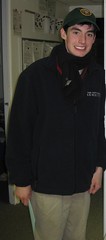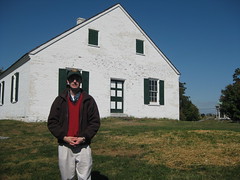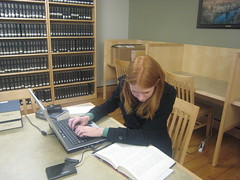 One of the most thrilling and exciting experiences that I have had in my life, was the opportunity to be a part of The Gettysburg Semester program at Gettysburg College. Through the many rewards that this experience offered me, perhaps one of the greatest was being able to work at Antietam National Battlefield. I knew that when offered an opportunity to take part in an internship; my first choice was to help out the wonderful Rangers and Volunteers who help to maintain this pristine battlefield and its history. It was my hope as I went into the program, to help preserve the stories and legacies of the men who fought at the Battle of Antietam, like my great-great grandfather Sgt. Neill T. Arnold of Company H in the 46th North Carolina Regiment. The over twenty-three thousand soldiers, who were killed, wounded, or missing from both sides, following the Battle of Antietam is just staggering. As well as the work done by both men and women from the surrounding communities who following the battle, took care of the wounded and buried the fallen soldiers, it is important that their legacy should also be remembered. I learned a great deal about the Battle of Antietam from my experience working there, through talking with the Rangers and other Volunteers, I came to a greater understanding of what the Battle of Antietam means to our national history and I consider it an honor to tell the stories of men like my great-great grandfather who fought on this hallowed ground.
One of the most thrilling and exciting experiences that I have had in my life, was the opportunity to be a part of The Gettysburg Semester program at Gettysburg College. Through the many rewards that this experience offered me, perhaps one of the greatest was being able to work at Antietam National Battlefield. I knew that when offered an opportunity to take part in an internship; my first choice was to help out the wonderful Rangers and Volunteers who help to maintain this pristine battlefield and its history. It was my hope as I went into the program, to help preserve the stories and legacies of the men who fought at the Battle of Antietam, like my great-great grandfather Sgt. Neill T. Arnold of Company H in the 46th North Carolina Regiment. The over twenty-three thousand soldiers, who were killed, wounded, or missing from both sides, following the Battle of Antietam is just staggering. As well as the work done by both men and women from the surrounding communities who following the battle, took care of the wounded and buried the fallen soldiers, it is important that their legacy should also be remembered. I learned a great deal about the Battle of Antietam from my experience working there, through talking with the Rangers and other Volunteers, I came to a greater understanding of what the Battle of Antietam means to our national history and I consider it an honor to tell the stories of men like my great-great grandfather who fought on this hallowed ground.  This experience of working at Antietam National Battlefield was one of the true joys of being a part of the Gettysburg Semester. I had the great privilege of living on the Gettysburg National Battlefield everyday for several months, and then being able to go and work at Antietam National Battlefield almost every weekend and sometimes during the regular week made the experience that much more rewarding. I usually worked every Sunday afternoon, and would make my trip down to Sharpsburg around mid-day following church at the Prince of Peace Episcopal Church in Gettysburg, Pennsylvania. I found the drive beautiful and relaxing, especially being able to drive through the Catoctin National Forrest, and in particular I was lucky to see the beautiful mountains and scenery covered in blankets of snow, which is something a young man from Tennessee is not always fortunate to see. My days usually consisted of working behind the Visitor Center Desk, helping the everyday visitors from across the United States and around the World with their visit to Antietam. I would point out the best ways to tour the Battlefield in however much time the visitor had, reminding them to make sure and see the Dunker Church, the Cornfield, the Sunken Road, and Burnside’s Bridge. I would go over the park map, a brief history of the battle, and show them the museum, as well as when the next documentary would be starting or when there was a Ranger led program. I was also able to travel out on the battlefield and take part in the Battlefield Ambassadors program. Which most volunteers have the opportunity to do as a way to help the visitor know a little more about a particular area of the battlefield and the action that occurred there on September 17, 1862. In my case that included the West Woods, where my great-great grandfather and the 46th North Carolina Regiment fought.
This experience of working at Antietam National Battlefield was one of the true joys of being a part of the Gettysburg Semester. I had the great privilege of living on the Gettysburg National Battlefield everyday for several months, and then being able to go and work at Antietam National Battlefield almost every weekend and sometimes during the regular week made the experience that much more rewarding. I usually worked every Sunday afternoon, and would make my trip down to Sharpsburg around mid-day following church at the Prince of Peace Episcopal Church in Gettysburg, Pennsylvania. I found the drive beautiful and relaxing, especially being able to drive through the Catoctin National Forrest, and in particular I was lucky to see the beautiful mountains and scenery covered in blankets of snow, which is something a young man from Tennessee is not always fortunate to see. My days usually consisted of working behind the Visitor Center Desk, helping the everyday visitors from across the United States and around the World with their visit to Antietam. I would point out the best ways to tour the Battlefield in however much time the visitor had, reminding them to make sure and see the Dunker Church, the Cornfield, the Sunken Road, and Burnside’s Bridge. I would go over the park map, a brief history of the battle, and show them the museum, as well as when the next documentary would be starting or when there was a Ranger led program. I was also able to travel out on the battlefield and take part in the Battlefield Ambassadors program. Which most volunteers have the opportunity to do as a way to help the visitor know a little more about a particular area of the battlefield and the action that occurred there on September 17, 1862. In my case that included the West Woods, where my great-great grandfather and the 46th North Carolina Regiment fought.
 Some other rewarding experiences were being able to help the visitors with any questions that they might have, and if they had an ancestor who fought at the Battle of Antietam, then I was able to provide for them a history of their ancestor’s unit, and show them where on the battlefield they fought, one-hundred and forty-seven years ago. I also enjoyed meeting all of the visitors, especially young children and would help them to become Junior Rangers. One of the greatest parts about working with the visitors, was you never knew who you were going to meet or see, from visitors across the United States and the world, to Ed Bearss and James McPherson, two leading Civil War Historians. I was rewarded each and every day that I was at Antietam National Battlefield, and in particular, I was fortunate to be a small part of two great events that occur at the battlefield each year. One being the Annual Battle Anniversary led Ranger program, which occurs each year on September 17, and begins early in the morning at seven o’clock in the Cornfield and ends in the late afternoon at the National Cemetery. It was truly a rewarding day and one that I got to share with my fellow companions from the Gettysburg Semester, as we walked all across the battlefield re-tracing the events that occurred on those fields one-hundred and forty-seven years ago. Another great experience, was being able to help with the Annual Remembrance Day Illumination, which occurs usually the first weekend of December as hundreds of volunteers from across the country come to place over twenty-three thousand luminaries across the battlefield to remember the brave soldiers of both the Union and Confederacy who were killed, wounded, or missing during the epic Battle of Antietam. That particular day was one in which snow kept falling throughout the day, as the volunteers worked hard to set out all of the luminaries, and even though the snow prevented some of them from being lighted, the symbol of sacrifice that they represented will never be forgotten.
Some other rewarding experiences were being able to help the visitors with any questions that they might have, and if they had an ancestor who fought at the Battle of Antietam, then I was able to provide for them a history of their ancestor’s unit, and show them where on the battlefield they fought, one-hundred and forty-seven years ago. I also enjoyed meeting all of the visitors, especially young children and would help them to become Junior Rangers. One of the greatest parts about working with the visitors, was you never knew who you were going to meet or see, from visitors across the United States and the world, to Ed Bearss and James McPherson, two leading Civil War Historians. I was rewarded each and every day that I was at Antietam National Battlefield, and in particular, I was fortunate to be a small part of two great events that occur at the battlefield each year. One being the Annual Battle Anniversary led Ranger program, which occurs each year on September 17, and begins early in the morning at seven o’clock in the Cornfield and ends in the late afternoon at the National Cemetery. It was truly a rewarding day and one that I got to share with my fellow companions from the Gettysburg Semester, as we walked all across the battlefield re-tracing the events that occurred on those fields one-hundred and forty-seven years ago. Another great experience, was being able to help with the Annual Remembrance Day Illumination, which occurs usually the first weekend of December as hundreds of volunteers from across the country come to place over twenty-three thousand luminaries across the battlefield to remember the brave soldiers of both the Union and Confederacy who were killed, wounded, or missing during the epic Battle of Antietam. That particular day was one in which snow kept falling throughout the day, as the volunteers worked hard to set out all of the luminaries, and even though the snow prevented some of them from being lighted, the symbol of sacrifice that they represented will never be forgotten.
All in all, my time spent as a member of the Gettysburg Semester Program, was truly one of the most rewarding experiences of my life. I learned so much from Dr. Guelzo, as well as all of the staff in the Civil War Era Studies Department and History Department at Gettysburg College that I will be able to carry the knowledge that I have gained from them for the rest of my life. I also had the fortune of meeting some wonderful new friends as part of the Gettysburg Semester, especially the eight of us semester students from around the country, Mrs. Cathy Bain, Mr. John Rudy and all of the other Gettysburg students and staff who I had the fortune of meeting. My time at the battlefield was one of the true highlights of my semester at Gettysburg College, and I cannot thank enough the extraordinary staff of Rangers and Volunteers at Antietam National Battlefield, who I had the privilege of coming into contact with and learning a great deal from. The experience of working at the battlefield was something that I will keep close to me forever and I hope that I was able in a small way to bring the stories of the men who fought there and what they went through to life, for our democracy was never more tested in one day than at the Battle of Antietam.



